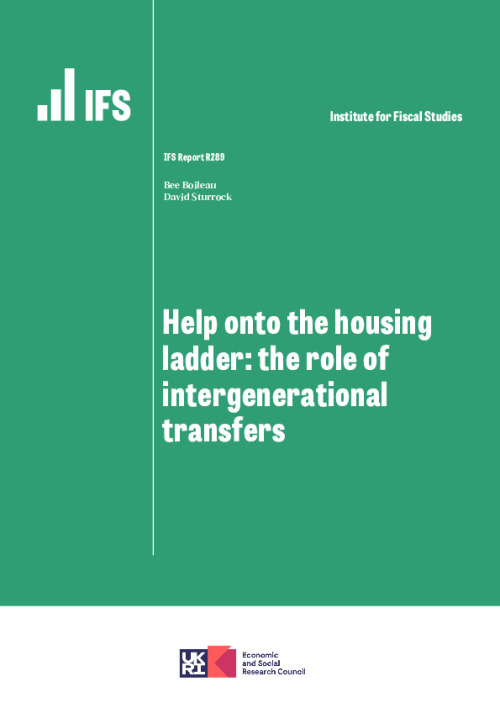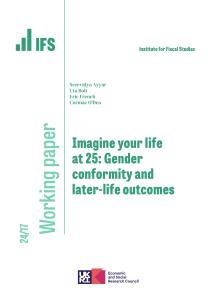This report describes patterns of financial help from family received by first-time buyers. We quantify the value of gifts and loans made, how they vary across different regions of the country and between those from different parental backgrounds, and shed light on their role in explaining inequalities in homeownership and wealth.
Key findings
- Homeownership rates for young people have declined dramatically in recent decades and this decline was more rapid for those who are in high-price areas such as London and those whose parents don’t own their own home. Between 2009 and 2019, the homeownership rate for those aged 25–39 fell from 55% to 43%. In this age group, the children of homeowners are now over twice as likely to be homeowners as the children of renters: the homeownership rate for the children of homeowners fell from 60% in 2009 to 51% in 2019, but for the children of renters it fell from 40% to 22% over the same period.
- Financial help around the time of home purchase is frequently received and substantial. In 2018–20, almost half of first-time buyers in their 20s received financial help, primarily from their parents, to purchase their house. Among all first-time buyers, deposits averaged around £55,000, with financial help averaging around £25,000 for those who received it. These transfers have the potential to help people buy a home earlier, buy a more expensive house, or put down a larger deposit.
- There are large inequalities in parental transfers at the time of home purchase. Over half of those with university-educated homeowning parents received transfers when buying for the first time, with receivers getting around £35,000 on average. This compares to 29% of those with renting parents receiving transfers, with an average transfer of £11,000. Average financial help received by first-time buyers in the South East was £31,000, compared to £18,000 in the Midlands and £17,000 in the North.Not all of these transfers are helping people to get onto the housing ladder. A significant minority of transfers received around the time of home purchase go to those who could already afford to buy, given their non-transfer savings. Around a quarter of first-time buyers who received financial transfers at the time of home purchase could have afforded to buy their house without these transfers, in that their savings (without the financial transfers) would cover a 10% deposit, and their savings plus a mortgage of 4.5 times their income would cover the value of the house they bought. But around three-quarters of those who received financial help might not have been able to afford the home they purchased without that help.
- Among those for whom transfers do help with home purchase, the impact of a pound of transfers depends on whether or not the receiver is unable to buy because they have insufficient savings to put down a 10% deposit. For almost two-thirds of first-time buyers, each £1,000 they receive from parents increases the value of the house they can buy not by £1,000 but by £10,000. This is because for this group the constraint on what they can buy comes from the deposit they can afford, which usually has to be 10% of the price of the house.
- Despite those in their 30s, those who have wealthier parents and those in the South East receiving larger amounts of financial assistance when buying a home, the transfers received by other groups of first-time buyers are likely to have more of an impact on the ability to purchase a house. One reason for this is that, among first-time buyers who received transfers, those in their 30s and those buying in the South East were around twice as likely to be able to afford to buy their house without this financial help than their counterparts in their 20s and in the North. In addition, each £1,000 in transfers received by those with university-educated homeowning parents increased the value of the house they could afford by around £2,700 on average. This compared to an increase of around £4,300 pounds for those with renting parents.
- Among those who receive a transfer when buying a house, those who receive more seem to use this additional money to put down more as a deposit rather than buying a more expensive house. Among those receiving transfers, each additional pound received in transfers is associated with putting an additional 77p down as a deposit.
- Using financial transfers to increase the size of the deposit put down has had potentially very high effective returns in recent years, because doing so can reduce the interest rate paid on the entirety of the mortgage. Using a typical transfer of £25,000 to put down a deposit of 25% rather than 10% of home value would reduce the repayments on a typical five-year fixed rate mortgage taken out in 2018 by £8,500. This compares to a return of around £850 if putting this in a typical cash ISA. This means that transfers around the time of home purchase may have large further knock-on effects on wealth accumulation, widening differences between those who receive more and those who receive less.
- Schemes that would reduce the deposit required from potential homebuyers are likely to have a bigger effect on affordability among those in their 30s, those who have better-off parents, and – in particular – those who live in the North or Midlands, rather than the South. These groups have higher incomes in relation to the house prices they face, meaning that more of them are prevented from getting on the housing ladder only by the need to raise a 10% deposit. Among renters aged 25–39 who can’t afford to buy a house at the 25th percentile of prices in their local authority when required to put down a 10% deposit, 29% of those in the North are constrained only by the deposit requirement, compared to just 9% of renters in the South.











